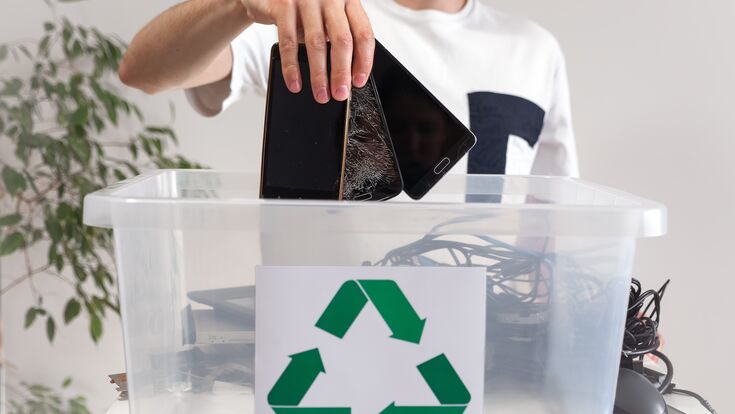E-Waste Recycling : "The growing volume of e-waste is quickly overwhelming the current capacity to recycle it"

Our lives are becoming ever more electrified. There are new phones, new tablets, and new laptops on the market every day. And all of those electronic devices end up as e-waste sooner or later, letting the e-waste stream grow immensely and making it the fastest-growing waste stream worldwide. This is a challenge – and an opportunity – for recyclers, as Mark Kasper, Chief Operations Officer for Clean Earth's Electronic and Universal Waste Division says.
Kasper is responsible for all operational aspects of the company's six electronic and universal waste facilities throughout the US. With over 30 years of experience in the hazardous waste industry and 17 years specialising in electronic and general waste, he has extensive operational knowledge across multiple sectors and waste technologies. With Waste Management World he talked about e-waste management and the future of the e-waste recycling sector.
How much e-waste is produced in the US?
In 2019, the United States produced 11.9 million tons of e-waste. For context, the continent of Asia produced 22.6 million tons. This number continues to grow.
Has it increased over the last five years?
E-waste generation has increased by 60% between 2010 and 2019. Globally, 50 million tons of e-waste is generated per year, and by 2030, that number will grow to 75 million tons.
How much of e-waste is still handled unsafely – in landfills, illegally exported to developing countries…?
The Global E-Waste Statistics Partnership (GESP) estimated that in 2019, only 17.4% of e-waste produced reached recycling facilities or was formally managed. Up to 82.6% of e-waste was illegally handled – and a large portion of that was dumped in low or middle-income countries.
According to the WHO, the proper disposal of 17.4% of e-waste prevented an estimated 15 million tons of carbon dioxide equivalent from being released into the atmosphere.

Why do you think is that the case?
Cost and absence of federal regulations contribute to the mishandling of e-waste; it’s cheaper to export e-waste than to build and develop local infrastructure for recycling, and currently, there are no federal laws that require it. We anticipate that the demand for e-waste management will increase with escalating pressure for companies to demonstrate their commitment to sustainability.
Would there be enough specialized recycling facilities the US to deal with the whole amount of e-waste? ?
The growing volume of e-waste is quickly overwhelming the current capacity to recycle it. E-waste recyclers require R2 certification.
Over the last couple of years, many bills regarding e-waste basically disappeared in Congress. Why do you think it is so difficult to pass e-waste legislation?
Lack of awareness of the dangers of improper e-waste disposal is one barrier to federal e-waste legislation. Environmental solutions companies like Clean Earth aim to provide education to both customers and consumers to increase awareness.
What role do EPR systems play in e-waste recycling?
EPR programs hold electronics manufacturers accountable for the full lifecycle of the products they produce, including waste disposal management. Manufacturers offer EPR programs that encourage customers to return their used electronics for recycling or refurbishment. This increases the amount of e-waste sent for reuse and recycling, further adding to the growth of proper e-waste management and the companies, like Clean Earth, that specialize in that management.
The growing volume of e-waste is quickly overwhelming the current capacity to recycle it.Mark Kasper, Clean Earth
What are the main challenges for e-waste recyclers?
Recyclers must properly handle e-waste to avoid toxin exposure at recycling facilities and ensure materials are recovered correctly. Because of the technical and sensitive nature of e-waste recycling, associated labor costs tend to be high.
Electronics are comprised of many complex materials like batteries, plastics, glass, and ferrous and non-ferrous metals. These materials must be processed carefully to avoid releasing harmful chemicals into the environment. Clean Earth takes steps to safely recover valuable commodities within e-waste for recycling and reuse.
Is there enough of a market for secondary raw materials coming from e-waste recycling?
Yes, there is enough of a market for secondary raw materials coming from e-waste recycling. This market will continue to grow as manufacturers make their operations more sustainable by relying on recycled raw materials. Clean Earth often sees these materials used to reproduce more electronics and create automotive parts, toys, stationery accessories, and more.
Why did Clean Earth decide to become a certified recycler? What are the benefits?
Having five R2/RIOS-certified facilities strategically located across the country ensures we and our customers are meeting all regulatory requirements and enables our commitment to proper end-of-life management of electronics. The newest R2V3 certification ensures future compliance and provides peace of mind.
Clean Earth’s R2/RIOS certifications heavily protect our business and customers from the data, health, safety, and environmental risks associated with e-waste disposal.
How do you see the future of e-waste recycling?
E-waste recycling is constantly growing. The future of e-waste recycling will be supported by the increasing number of electronics used every day and the emergence of new technologies. Additionally, educational efforts from companies like Clean Earth and widespread environmental messaging are increasing public knowledge about proper electronics disposal. This, combined with the next generation of environmentally conscious consumers and corporations interested in responsible e-waste disposal, contributes to a strong future for e-waste recycling.


